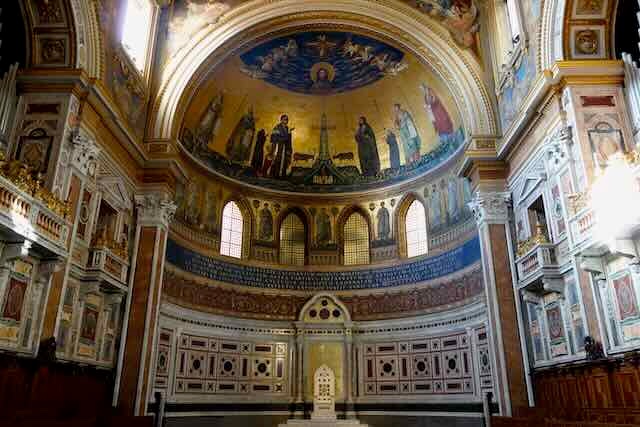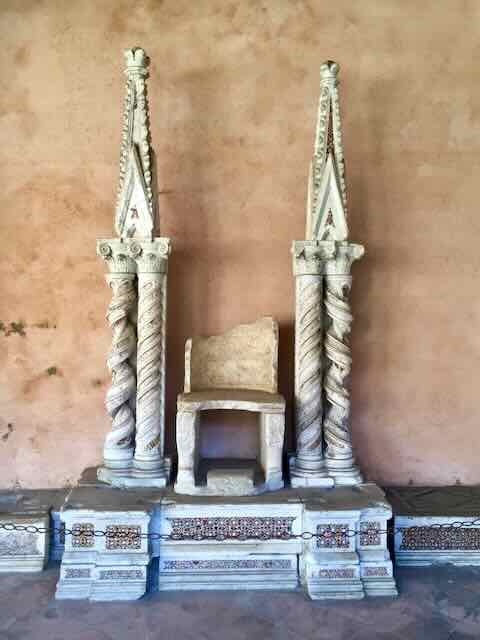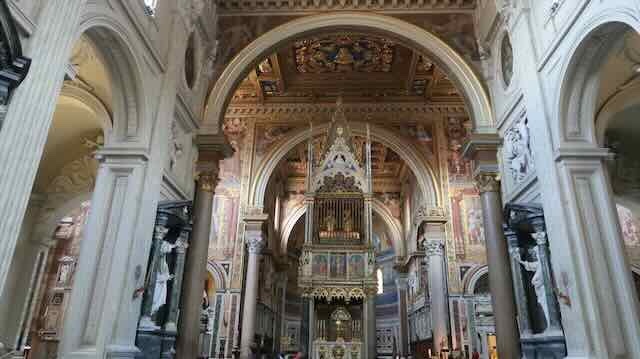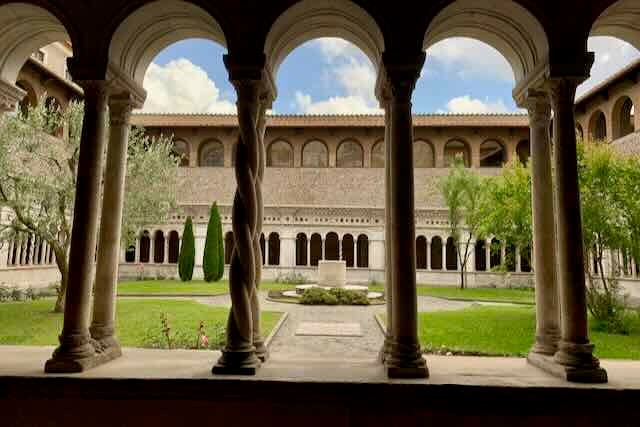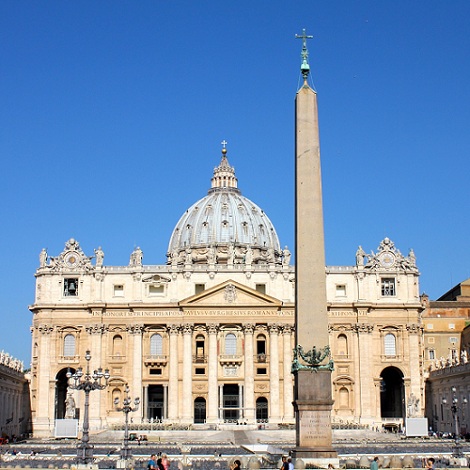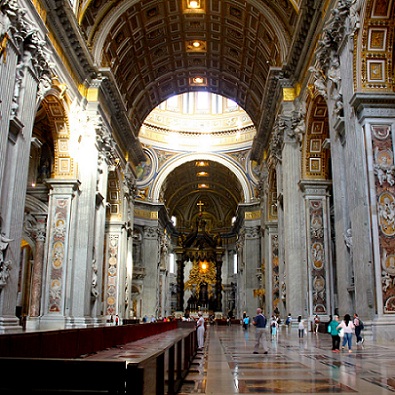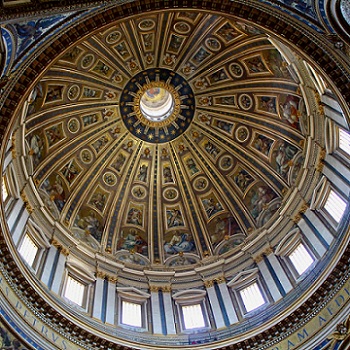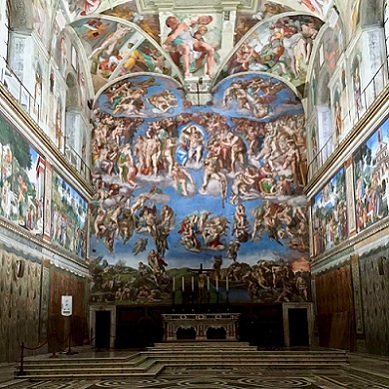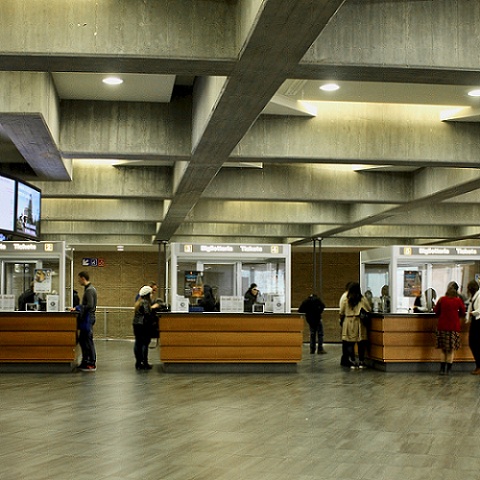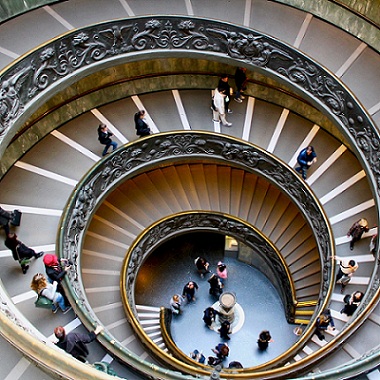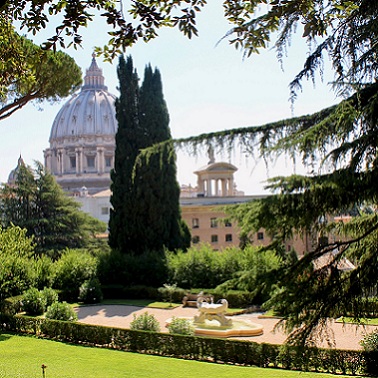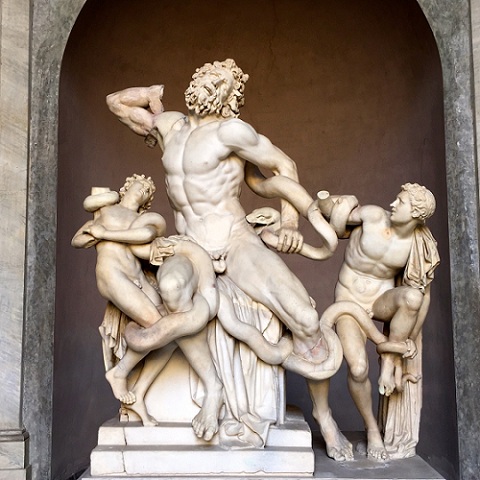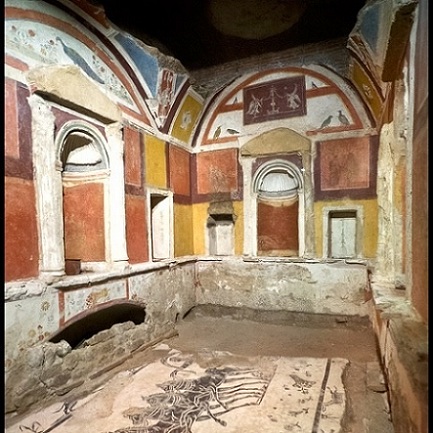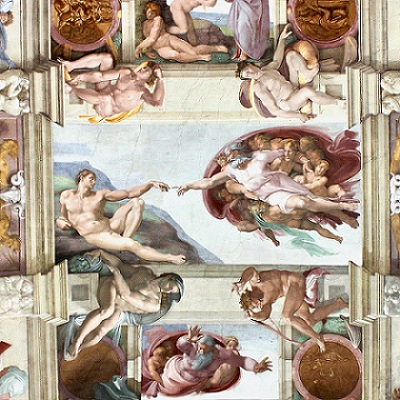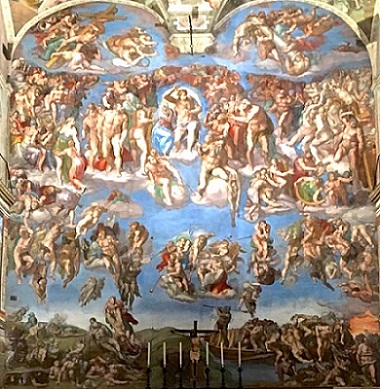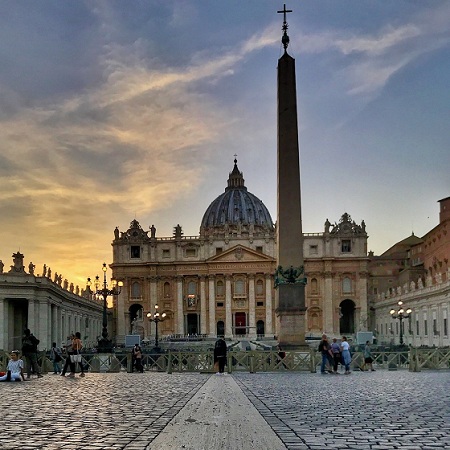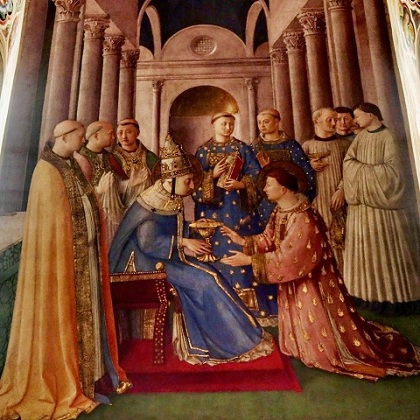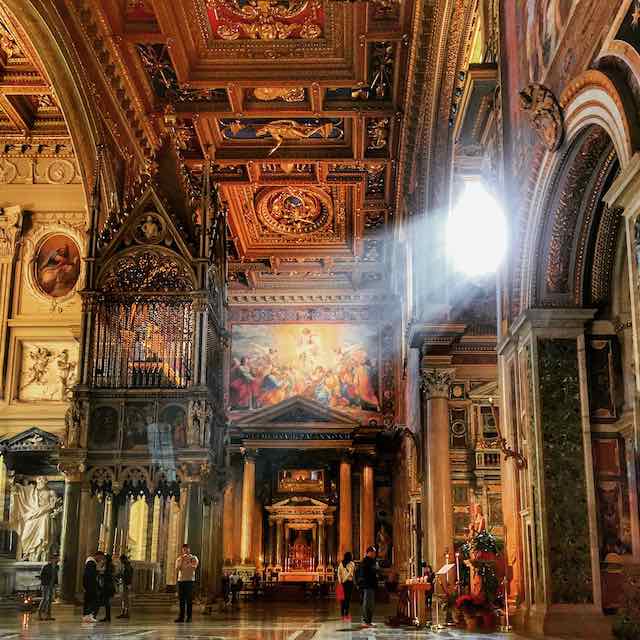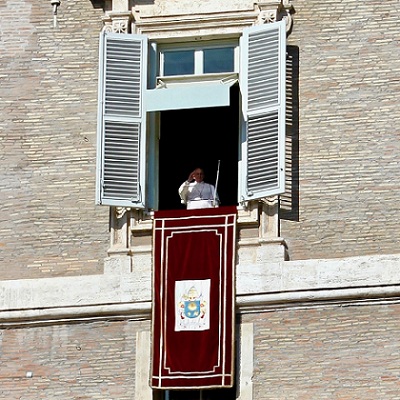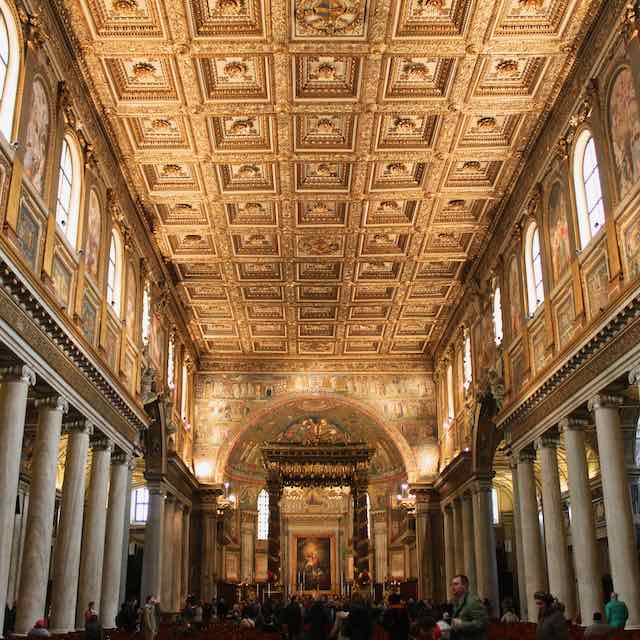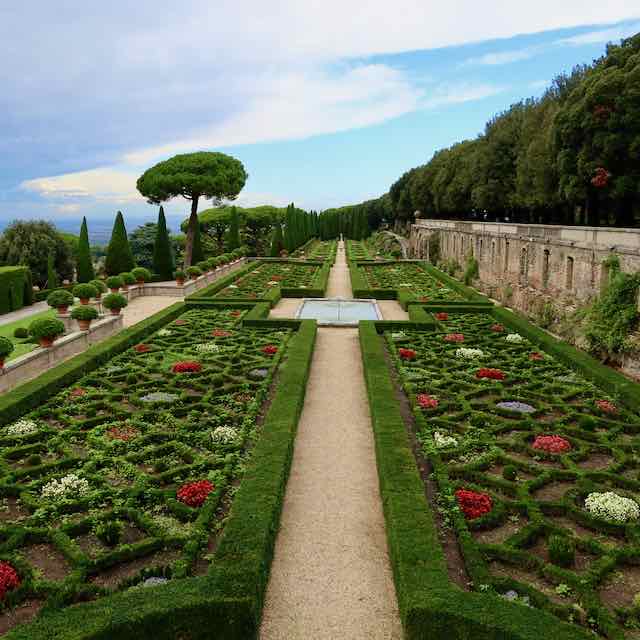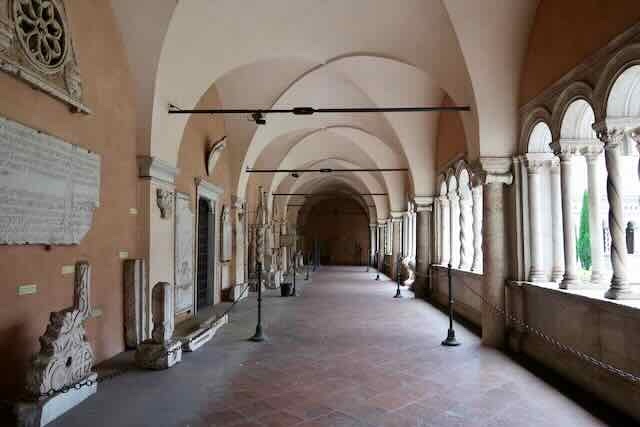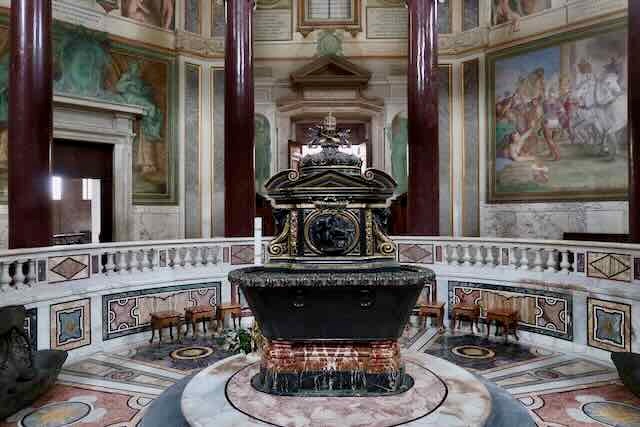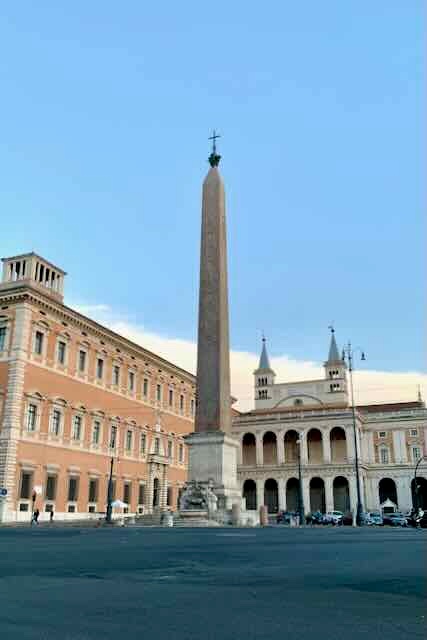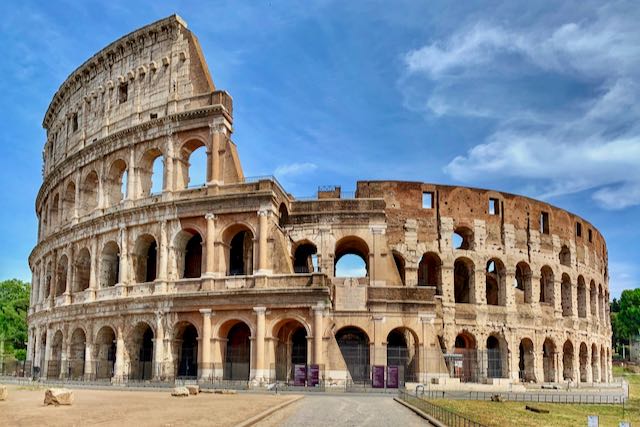- Sign up & get a FREE ebook Subscribe NOW!
- Romewise Home Page
- Rome Tourist Attractions
- St John Lateran
Basilica of St. John Lateran - Why it's one of the most important churches in Rome
Why is the Basilica of St. John Lateran one of the most important Catholic churches in Rome, if not the world?
Read on to discover why this cathedral is so important, and how you can visit it.
On this page we'll cover:
- Why is the Basilica of St John Lateran important?
- When was the Archbasilica of Saint John Lateran built?
- What is the origin of the bronze doors of the Lateran palace?
- What are the statues on top of St John Lateran?
- What important things are there to see inside the Basilica of St. John in Lateran?
- Is the Lateran Basilica in the Vatican?
- What was the Lateran Treaty?
- What is the best way to visit the Basilica of Saint John in Lateran?
- What are the Mass times in St. John Lateran?
- What else is there to see nearby?
- How to get to St. John Lateran cathedral?
Why is the Basilica of St John Lateran important?
There are 4 papal basilicas in the world, all in Rome.
St. John Lateran is the most important of them all, because it is the home of the bishop of Rome, the Pope.
Pope Francis lives in Vatican City, and performs mass more often at Saint Peter's Basilica than at the other papal basilicas, but St. John Lateran is the Pope's church in Rome.
Generally special masses are held here, such as the one on Holy Thursday during Easter week.
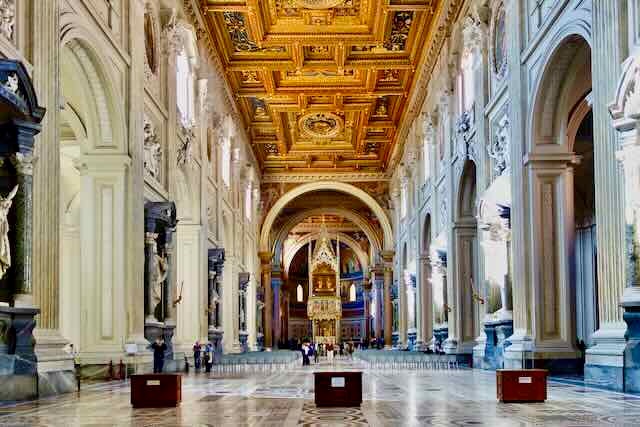 When you first enter the central nave of the cathedral, take a moment to admire all its treasures on display before exploring further!
When you first enter the central nave of the cathedral, take a moment to admire all its treasures on display before exploring further!The church is also known as the Archbasilica of Saint John in Lateran (Basilica di San Giovanni in Laterano in Italian) because it's considered the mother church of all the churches by Roman Catholics.
And it's not only the oldest Catholic church in Rome, it's the oldest church in the West - older even than St Peter's Basilica!
What does the word Lateran mean?
Lateran means "belonging to the Laterani family" in Latin.
In the fourth century, a family named the Laterani owned a large piece of land on the Caelian Hill, where the basilica now stands.
The family sold the land to Emperor Constantine I in the year 313.
He then gave it to Pope Miltiades, who built a church on the property.
The Lateran palace was once the home of the popes before the residence moved to the Vatican.
You can see the Lateran Palace just next door to the church.
Did you know the Pope has a summer residence?
It's just outside of Rome at Castel Gandolfo.
When was the Archbasilica of Saint John Lateran built?
The first church on this site was consecrated by Pope Sylvester I in 324.
Originally the church was dedicated to Christ the Redeemer.
It was later also dedicated to Saint John the Baptist, and then to Saint John the Evangelist.
That church was destroyed in the 5th century by Vandals and Visigoths.
Over the next centuries, it survived fires and an earthquake in 897.
It was rebuilt every time.
The current building dates from the 17th century, mostly to designs by Francesco Borromini, and is a beautiful example of Baroque architecture.
Important architects who worked on the Lateran basilica
Over the centuries, the basilica was repaired or reworked under various popes.
The most important renovations were carried out by Francesco Borromini between 1646 and 1667, and by Alessandro Galilei in 1735.
Other important architects who worked on this church include Giacomo della Porta and Domenico Fontana.
⭐️ Marvel at Rome's Stunning Architecture ⭐️
Dive into Rome's majestic basilicas and architectural marvels. Visit San Giovanni, Santa Maria Maggiore, and the Pantheon to uncover the rich history and beauty of these iconic sites.
What is the origin of the bronze doors of the Lateran palace?
The enormous bronze doors at the entrance of St. John Lateran once belonged to the Curia Julia, or Senate House in the Roman Forum.
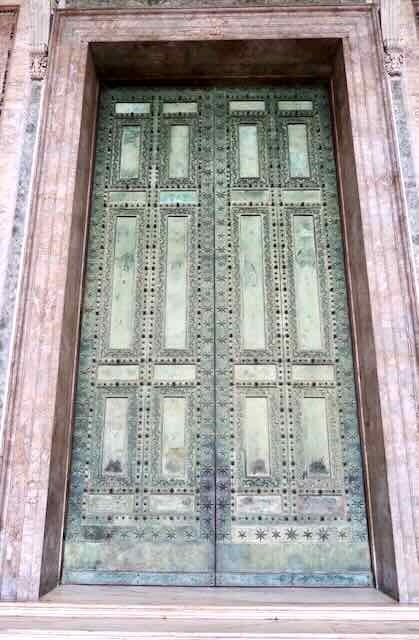 An excellent example of artefacts from the Roman Empire being reused, the bronze central doors of the basilica were once the doors to the ancient Senate building.
An excellent example of artefacts from the Roman Empire being reused, the bronze central doors of the basilica were once the doors to the ancient Senate building.They may have been made when the Curia was first built in 29 BCE.
Or, they may have been made under Emperor Domitian in the 1st century.
Finally, it's possible they were made, or at least re-cast, under Emperor Diocletian in the 3rd century after the Curia and its doors were destroyed in a huge fire.
The doors were brought to adorn San Giovanni in Laterano in 1660 when people were starting to discover ancient Roman history more, like the Colosseum.
As huge as they were, they are too small for the space they were to fill, so a frame was built around them.
What are the statues on top of St John Lateran?
In the early 18th century, the façade was designed by Alessandro Galilei, a relative of Galileo Galilei.
There is a 7-meter tall statue of Jesus on the central pediment, with statues of St. John the Baptist and St. John the Evangelist on each side.
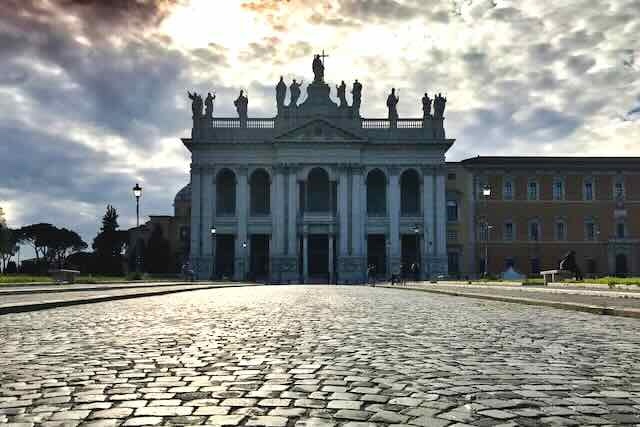 You'll need to walk back from the front of the church to get a good view of the statues on top of the façade
You'll need to walk back from the front of the church to get a good view of the statues on top of the façadeThey in turn are flanked by the 12 Doctors of the Greek and Latin Churches.
What important things are there to see inside the Basilica of St. John in Lateran?
The "Cattedra"
The word cathedral comes from the word "cathedra", meaning chair.
This refers to the special chair on which the bishop, or in this case the pope, presides over services.
In the apse of Saint John Lateran, you can see a medieval papal cathedra.
There is an even older one in the Cosmatesque cloister (see below.)
A Catholic church without a bishop is not a cathedral.
This is the reason Saint Peter's Basilica is not a cathedral - it has no bishop.
Relics
In St. John Lateran, you will find several important relics.
The 14th-century Gothic ciborium (canopy) contains a relic of the original wooden altar used by Saint Peter.
It also contains two images of Saints Peter and Paul, the patron saints of Rome.
These busts contain what are said to be their respective skulls, or at least parts of their skulls.
To the left of the main altar is the Altar of the Holy Sacrament.
At the top, there is a small bronze relief sculpture depicting the Last Supper.
Behind this, in a reliquary, is a fragment of the table used at that meal.
No matter what season you visit Rome, here are 4 essential things we recommend never leaving home without:
Cosmatesque Cloister
Inside the Basilica of St. John Lateran, there is an exquisite Cosmatesque cloister, built between 1288 and 1350.
To visit the cloister, you'll need to purchase a ticket.
The cloister is open from Monday to Saturday 9:00 to 18:00, and on Sundays and holidays from 13:00 to 18:00.
Tickets cost 8€ for adults, 5€ for students and seniors, and are free for children under 6 years old.
The perfect 3-day itinerary in Rome
Trying to figure out how to organize your visit to Rome? I've got the perfect 3-day itinerary for first-time visitors (or those who have not been here in a while.) It works for a 2.5 day visit as well.
In my 3-day itinerary, you'll see all the major must-see Rome attractions like the Vatican, Colosseum, Trevi Fountain, Pantheon, Piazza Navona, Spanish Steps, and much more.
And if you have more time, or want suggestions for extra/other things to do, you'll find that there too.
Visit my page with the best 3-day itinerary in Rome for first-timers.
Is the Lateran Basilica in the Vatican?
There are 4 papal basilicas, actually known as the four Major Basilicas, and they are all in Rome.
Or rather, three of them are in Rome and one, Saint Peter's Basilica, is in Vatican City.
The other three, Saint John Lateran (San Giovanni in Laterano), Saint Mary Major (Santa Maria Maggiore), and Saint Paul Outside the Walls (San Paolo Fiori le Mura), are technically in Rome.
However, thanks to the Lateran Treaty, they are all considered property of the Vatican, and therefore functionally part of Vatican City.
San Giovanni in Laterano is the official cathedral church of Rome, even though it is not in Vatican City.
Any police you see inside these churches are Vatican police rather than Italian police.
What was the Lateran Treaty?
The Lateran Treaty was a treaty between the Kingdom of Italy and the Holy See, signed on February 11, 1929.
It recognized Vatican City as an independent state and granted Catholicism special status in Italy.
What is the best way to visit the Basilica of Saint John in Lateran?
St. John Lateran Basilica is open every day from 7:00 to 19:00.
Admission is free, but if you want to visit the cloister, you'll need to purchase a ticket, which you can do inside the basilica on the left-hand side.
If you're interested in learning more about the history and art of one of the most famous churches in Rome, we recommend St John Lateran's basilica tours, or you can book an audio guide if you prefer to explore at your own pace.
What are the Mass times in St. John Lateran?
Mass times in St. John Lateran are :
- Weekdays: 7:00, 8:00, 9:00 (in Italian), 12:00 (in Latin), 18:00 (in English)
- Saturday: 7:00, 8:00, 9:00 (in Italian), 18:00 (in English)
- Sunday: 7:00, 8:00, 9:00 (in Italian), 10:30, 12:00 (in Latin), 18:00 (in English)
What else is there to see nearby?
Whether you are on a religious pilgrimage, or just want to see more art and historical artifacts, you could easily spend a full day near this Catholic church.
Disclosure: If you make a purchase through a link on this page, I may receive a small commission - at no extra cost to you. Thank you for supporting my site!
The Holy Stairs/Sancta Santorum
The Holy Stairs, Scala Sancta, are located in a building attached to the basilica.
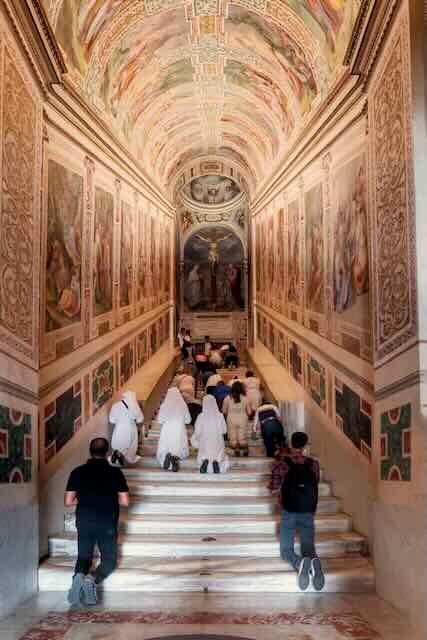 Pilgrims climb the holy stairs on their knees, but you can walk up a separate set of stairs alongside them as well.
Pilgrims climb the holy stairs on their knees, but you can walk up a separate set of stairs alongside them as well.They are, allegedly, the stairs that Christ climbed when he appeared before Pontius Pilate.
For a long time, only pilgrims who crawled up the 28 steps on their knees were allowed to ascend them, but you can also walk up (or take the elevator).
Looking for the complete Lateran complex experience?
Book this exclusive tour where you will see the basilica, the Cosmatesque cloister, the baptistery and the Holy Stairs for a truly in-depth visit!
Santa Croce in Gerusalemme/Holy Cross in Jerusalem
Further along the street is the Basilica of the Holy Cross in Jerusalem (Santa Croce in Gerusalemme), which contains some of the wood from the crucifixion cross, as well as pieces of the crown of thorns.
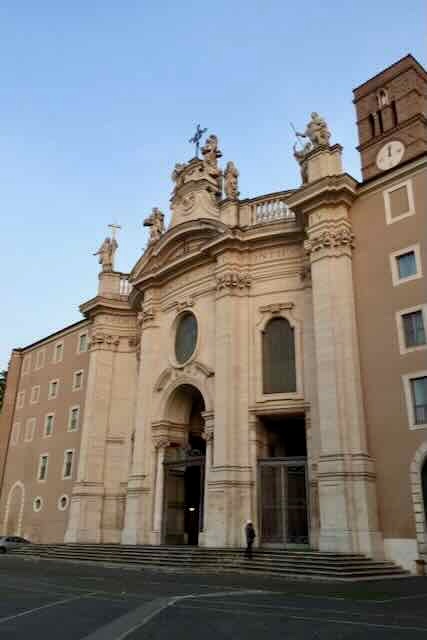 The church of Santa Croce in Gerusalemme
The church of Santa Croce in GerusalemmeIt also has a gorgeous original Cosmatesque floor.
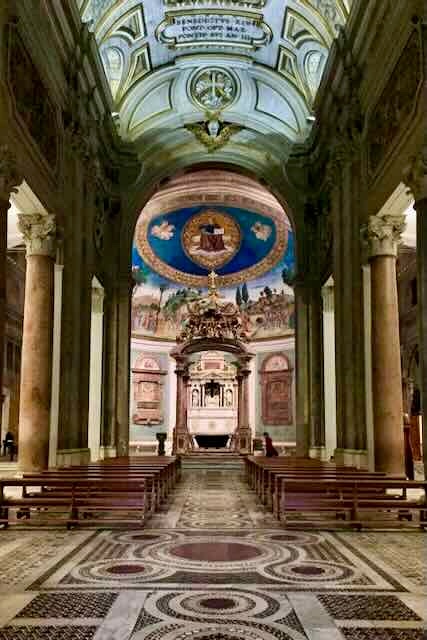 The inside of the church of Santa Croce in Gerusalemme
The inside of the church of Santa Croce in GerusalemmeExplore this gorgeous church on a small group walking tour which also takes in the Holy Stairs and the main basilica of St John in Lateran.
Ready to plan your trip?
Book your train
Planning to travel between cities in Italy and other parts of Europe?
Use Trainline to see all the different options available across the different rail companies.
Find your hotel
Find your perfect place to stay in Rome.
Use Booking.com to choose between hotels, guesthouses, and self-catering apartments in neighborhoods throughout the Eternal City.
Buy your TurboPass
Purchase the convenient Turbopass and visit all of Rome's top attractions including the Colosseum, Pantheon, and Vatican.
With one handy pass, it's all included.
The Lateran Baptistery
The Lateran Baptistery (Battistero Lateranense) is a separate building behind the church.
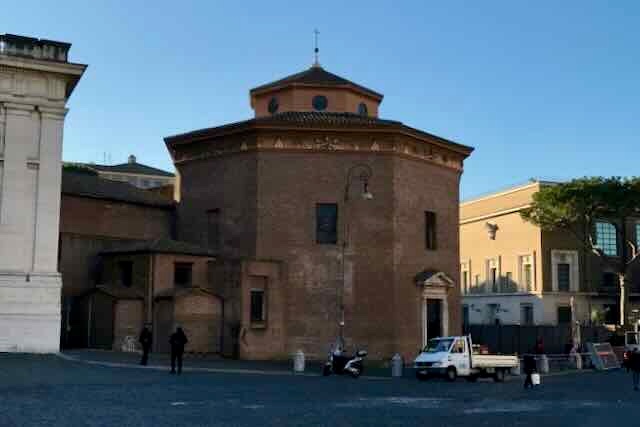 Outside view of the Lateran Baptistery
Outside view of the Lateran BaptisteryIt's the oldest standing baptistery in Rome, and was once the main baptistery for the city.
Today the baptistery is a functioning church, it is open every day from 9:00 to 12:00 and 15:00 to 18:00.
Admission is free.
The Lateran Obelisk
Adjacent to the church stands one of Rome's ancient Egyptian obelisks, from around the 15th century BCE.
It originally stood in Karnak.
Roman Emperor Constantius II (not Emperor Constantine as many believe) had it brought to Rome in 357 CE and had it placed along the spine of the Circus Maximus.
It is the tallest standing Egyptian obelisk in the world, at over 105 feet (32 meters) tall.
If you include the cross and base, it reaches nearly 151 feet (46 meters).
It weights 455 tons.
While is is one of the oldest, if not THE oldest obelisk in Rome, it was the last to be brought to Rome from Egypt.
(The obelisk in Saint Peter's Square may or may not be older, but its exact age is disputed.)
It was moved to its current location in 1588 under Pope Sixtus V.
How to get to St. John Lateran cathedral?
The best way to get to St. John Lateran is by public transportation.
The basilica is located near two metro stops, Manzoni and San Giovanni, on Line A.
Many buses stop here as well.
The basilica is located less than 30 minutes' walk from the Colosseum.
It's also less than 30 minutes' walk from Santa Maria Maggiore in a different direction, so it's easy to visit Saint John Lateran and one of these other two sites on the same day.
Romewise's Top Travel Resources
Ready to book your trip to Rome? Take a look at these helpful links to companies we use and trust:
- Keep your travel spending simple with the Wise card, which removes all the worry about exchange rates and high transaction fees all over the world
- Search for and book your perfect accommodation
- Our complete guide to what to pack for Rome
- The number one travel accessory, a multi-point travel adapter and voltage converter
- Browse a huge range of tours in Rome and beyond
- Experience unique tours and special access to Rome's most popular sights
- Protect yourself with comprehensive travel insurance
Within this post there are some affiliate links for products and services. For more details about our affiliate policy click here.
Get your 100% free Rome trip planner now!
Simply sign-up today for our free newsletter and get the Romewise Quick Start guide to Rome:
We are committed to respecting your data. Click for our Privacy Policy.
Comments? Questions? Suggestions?
Please come over to the private Romewise Facebook group and join in the conversation.
You will often find me there, happy to answer your questions / comments!
You will also meet other Rome lovers and experts, too.
What are you waiting for?
- Romewise Home Page
- Rome Tourist Attractions
- St John Lateran


